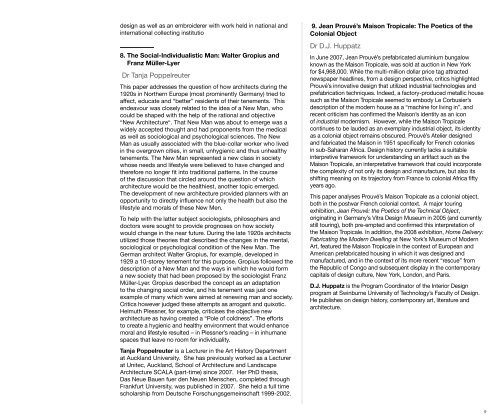2009 AAANZ Conference Abstracts - The Art Association of Australia ...
2009 AAANZ Conference Abstracts - The Art Association of Australia ...
2009 AAANZ Conference Abstracts - The Art Association of Australia ...
Create successful ePaper yourself
Turn your PDF publications into a flip-book with our unique Google optimized e-Paper software.
design as well as an embroiderer with work held in national and<br />
international collecting institutio<br />
8. <strong>The</strong> Social-Individualistic Man: Walter Gropius and<br />
Franz Müller-Lyer<br />
Dr Tanja Poppelreuter<br />
This paper addresses the question <strong>of</strong> how architects during the<br />
1920s in Northern Europe (most prominently Germany) tried to<br />
affect, educate and “better” residents <strong>of</strong> their tenements. This<br />
endeavour was closely related to the idea <strong>of</strong> a New Man, who<br />
could be shaped with the help <strong>of</strong> the rational and objective<br />
“New Architecture“. That New Man was about to emerge was a<br />
widely accepted thought and had proponents from the medical<br />
as well as sociological and psychological sciences. <strong>The</strong> New<br />
Man as usually associated with the blue-collar worker who lived<br />
in the overgrown cities, in small, unhygienic and thus unhealthy<br />
tenements. <strong>The</strong> New Man represented a new class in society<br />
whose needs and lifestyle were believed to have changed and<br />
therefore no longer fit into traditional patterns. In the course<br />
<strong>of</strong> the discussion that circled around the question <strong>of</strong> which<br />
architecture would be the healthiest, another topic emerged.<br />
<strong>The</strong> development <strong>of</strong> new architecture provided planners with an<br />
opportunity to directly influence not only the health but also the<br />
lifestyle and morals <strong>of</strong> these New Men.<br />
To help with the latter subject sociologists, philosophers and<br />
doctors were sought to provide prognoses on how society<br />
would change in the near future. During the late 1920s architects<br />
utilized those theories that described the changes in the mental,<br />
sociological or psychological condition <strong>of</strong> the New Man. <strong>The</strong><br />
German architect Walter Gropius, for example, developed in<br />
1929 a 10-storey tenement for this purpose. Gropius followed the<br />
description <strong>of</strong> a New Man and the ways in which he would form<br />
a new society that had been proposed by the sociologist Franz<br />
Müller-Lyer. Gropius described the concept as an adaptation<br />
to the changing social order, and his tenement was just one<br />
example <strong>of</strong> many which were aimed at renewing man and society.<br />
Critics however judged these attempts as arrogant and quixotic.<br />
Helmuth Plessner, for example, criticises the objective new<br />
architecture as having created a “Pole <strong>of</strong> coldness”. <strong>The</strong> efforts<br />
to create a hygienic and healthy environment that would enhance<br />
moral and lifestyle resulted – in Plessner’s reading – in inhumane<br />
spaces that leave no room for individuality.<br />
Tanja Poppelreuter is a Lecturer in the <strong>Art</strong> History Department<br />
at Auckland University. She has previously worked as a Lecturer<br />
at Unitec, Auckland, School <strong>of</strong> Architecture and Landscape<br />
Architecture SCALA (part-time) since 2007. Her PhD thesis,<br />
Das Neue Bauen fuer den Neuen Menschen, completed through<br />
Frankfurt University, was published in 2007. She held a full time<br />
scholarship from Deutsche Forschungsgemeinschaft 1999-2002.<br />
9. Jean Prouvé’s Maison Tropicale: <strong>The</strong> Poetics <strong>of</strong> the<br />
Colonial Object<br />
Dr D.J. Huppatz<br />
In June 2007, Jean Prouvé’s prefabricated aluminium bungalow<br />
known as the Maison Tropicale, was sold at auction in New York<br />
for $4,968,000. While the multi-million dollar price tag attracted<br />
newspaper headlines, from a design perspective, critics highlighted<br />
Prouvé’s innovative design that utilized industrial technologies and<br />
prefabrication techniques. Indeed, a factory-produced metallic house<br />
such as the Maison Tropicale seemed to embody Le Corbusier’s<br />
description <strong>of</strong> the modern house as a “machine for living in”, and<br />
recent criticism has confirmed the Maison’s identity as an icon<br />
<strong>of</strong> industrial modernism. However, while the Maison Tropicale<br />
continues to be lauded as an exemplary industrial object, its identity<br />
as a colonial object remains obscured. Prouvé’s Atelier designed<br />
and fabricated the Maison in 1951 specifically for French colonies<br />
in sub-Saharan Africa. Design history currently lacks a suitable<br />
interpretive framework for understanding an artifact such as the<br />
Maison Tropicale, an interpretative framework that could incorporate<br />
the complexity <strong>of</strong> not only its design and manufacture, but also its<br />
shifting meaning on its trajectory from France to colonial Africa fifty<br />
years ago.<br />
This paper analyses Prouvé’s Maison Tropicale as a colonial object,<br />
both in the postwar French colonial context. A major touring<br />
exhibition, Jean Prouvé: the Poetics <strong>of</strong> the Technical Object,<br />
originating in Germany’s Vitra Design Museum in 2005 (and currently<br />
still touring), both pre-empted and confirmed this interpretation <strong>of</strong><br />
the Maison Tropicale. In addition, the 2008 exhibition, Home Delivery:<br />
Fabricating the Modern Dwelling at New York’s Museum <strong>of</strong> Modern<br />
<strong>Art</strong>, featured the Maison Tropicale in the context <strong>of</strong> European and<br />
American prefabricated housing in which it was designed and<br />
manufactured, and in the context <strong>of</strong> its more recent “rescue” from<br />
the Republic <strong>of</strong> Congo and subsequent display in the contemporary<br />
capitals <strong>of</strong> design culture, New York, London, and Paris.<br />
D.J. Huppatz is the Program Coordinator <strong>of</strong> the Interior Design<br />
program at Swinburne University <strong>of</strong> Technology’s Faculty <strong>of</strong> Design.<br />
He publishes on design history, contemporary art, literature and<br />
architecture.<br />
9



